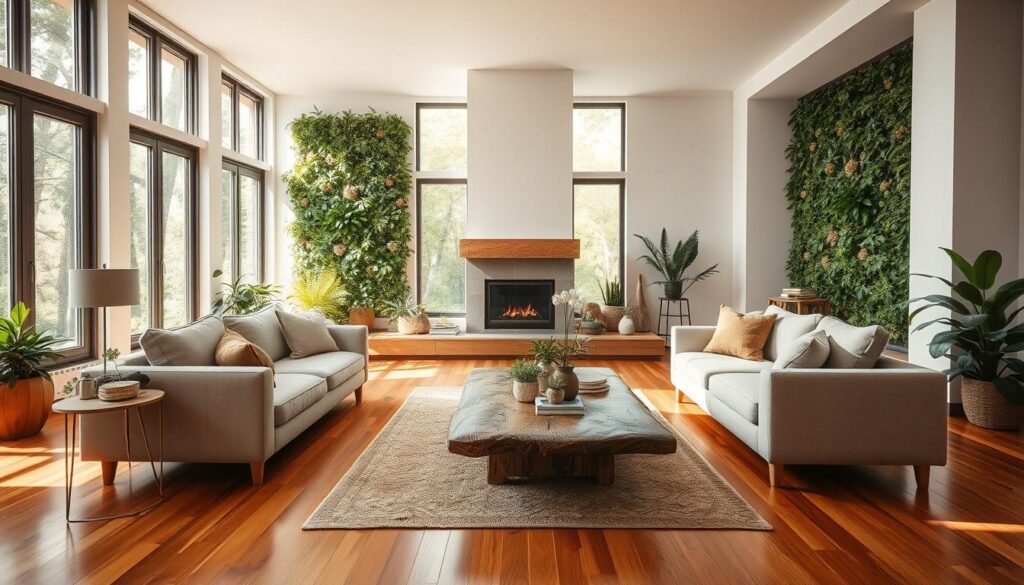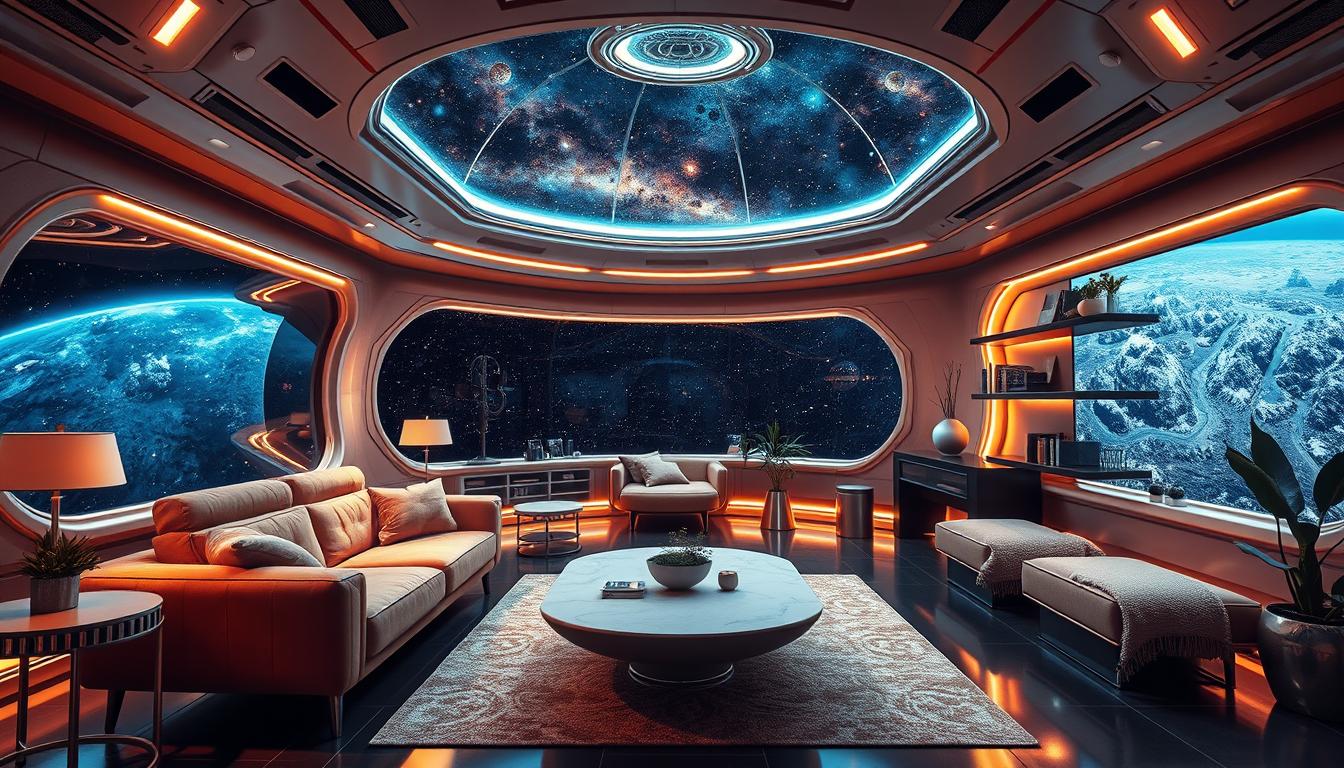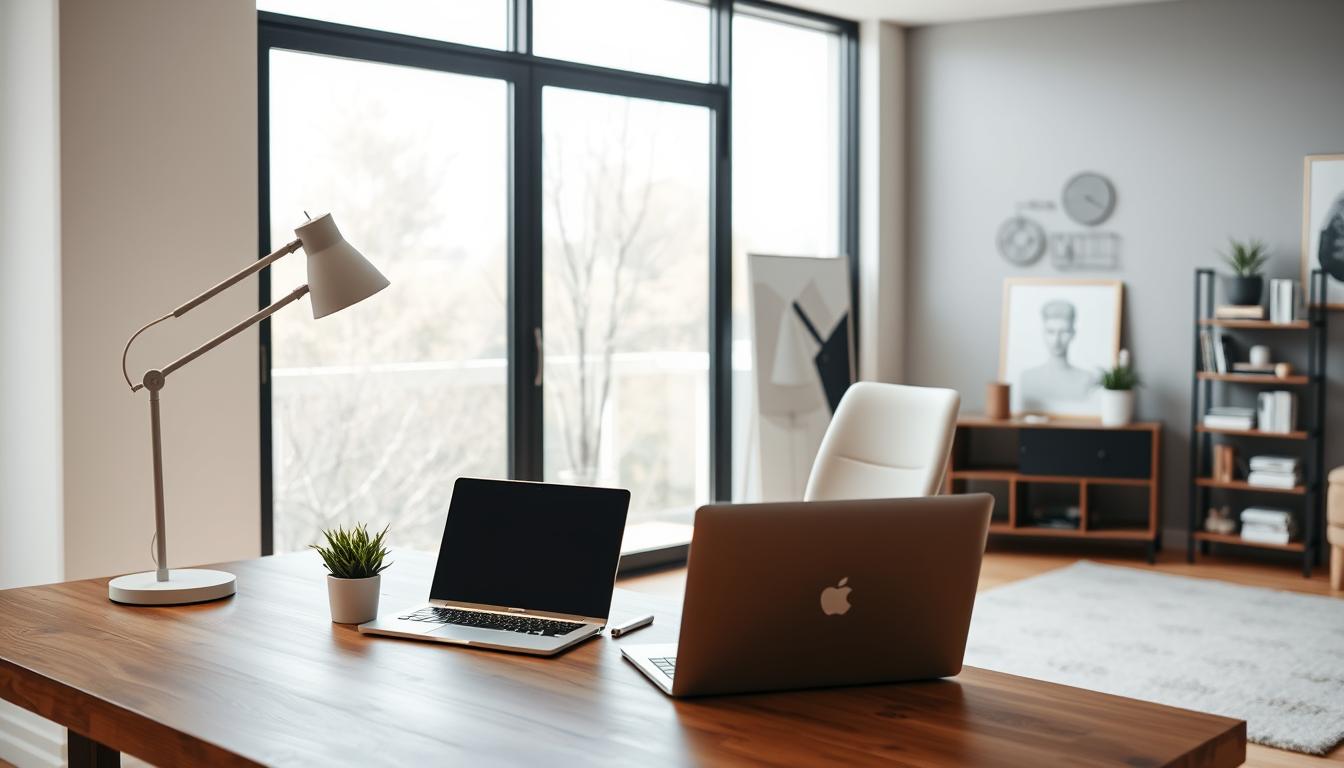Did you know a well-designed living space can make you happier and more productive? Creating a stylish space is more than just looks. It’s about making a place that shows who you are and makes you feel good.
Every beautiful interior decorating project starts with a careful mix of function and style. We’ll share tips and trends to help you find the perfect balance in your home.
We’ll show you how to pick the right colors and add special pieces. You’ll learn how to turn your space into a beautiful and useful haven.
Key Takeaways
- Understand the importance of a well-designed living space
- Learn how to balance functionality with style
- Discover the latest trends in interior decorating
- Explore tips for selecting the perfect color palette
- Create a harmonious and beautiful space
Understanding Home Interior Design Basics
Creating a beautiful home interior is all about understanding design basics. It’s a mix of art and science. You need to think about color, lighting, furniture, and texture.
What is Home Interior Design?
Home interior design makes your home look and feel better. It’s about knowing your space and what you need. It also involves using design principles to get the look you want. Good design can make you feel better and work better.
Key Elements of Interior Design
Interior design has several key elements. These are:
- Color: Color can change how a room feels. It can make you feel happy or calm.
- Lighting: Lighting is important for looks and function. It can highlight features and set the mood.
- Furniture: Choosing furniture is key for comfort and style. It should fit the room and your design.
- Texture: Texture adds depth to a room. You can use wood, fabric, and metal to create interest.
Different Styles to Consider
There are many styles in home interior design. Each has its own look and feel. Some popular ones are:
- Scandinavian: This style is all about simplicity and natural light.
- Japandi: It’s a mix of Japanese and Scandinavian, focusing on natural materials.
- Boho: Bohemian style is all about being eclectic and free-spirited.
Knowing these basics and styles helps you design your home. You can make a space that shows your personality and meets your needs.
Defining Your Personal Style
Defining your personal style means making a space that truly feels like yours. It’s about mixing comfort with beauty. When we dive into interior decorating, knowing your style is key. It helps make a home that looks great and feels uniquely yours.
How to Identify Your Aesthetic
Figuring out your aesthetic starts with thinking about your lifestyle and what you like. Consider how you use your living areas. For example, if you love hosting parties, your living room design should be perfect for guests. Think about the colors, textures, and furniture that you find appealing.
To begin, look for inspiration everywhere. Home decor magazines, Pinterest, or even nature can spark ideas. As design expert Kelly Wearstler once said, “The most important thing is to create a space that you love being in.”
“The most important thing is to create a space that you love being in.” – Kelly Wearstler
- Collect images that resonate with you.
- Identify common themes or elements.
- Consider how these elements can be incorporated into your space.
Blending Styles for a Unique Look
Mixing different styles can make your space truly unique. You can combine modern furniture with old pieces or minimalist decor with unique artwork. The trick is to find something that ties everything together, like a common color or texture.
In a living room design, pair a modern sofa with a vintage coffee table and colorful throw pillows. Mixing old and new adds depth and interest to your space.
- Start with a neutral base that allows for flexibility.
- Add statement pieces that reflect your personality.
- Balance different styles to avoid visual clutter.
By following these tips and staying true to your aesthetic, you can make a home that’s stylish and truly yours. As we keep exploring interior decorating, remember your home should show who you are.
Color Selection Strategies for Your Space
Choosing the right colors is crucial for home decor ideas. The colors you pick can make a room feel bigger, cozier, or more lively. It’s all about creating a welcoming atmosphere.
Colors do more than just look good; they affect how we feel. For example, blue can calm us down, while red energizes us. Knowing this can guide your color choices for your bedroom decoration and other spaces.
The Psychology of Colors in Design
Color psychology is key in interior design. Different hues can trigger different emotions and moods. Cool colors like blue and green can bring peace, while warm colors like orange and red can spark conversation and energy.
Before picking paint colors, designers consider several things. They think about the room’s purpose, lighting, and furniture. An article on The Spruce says designers ask questions like “What’s the room for?” and “How much light does it get?” Knowing these answers helps pick a color that works well with the space.
| Color | Emotional Response | Best Used In |
|---|---|---|
| Blue | Calmness, Serenity | Bedrooms, Bathrooms |
| Red | Energy, Passion | Living Rooms, Dining Rooms |
| Green | Balance, Harmony | Living Rooms, Offices |
Tips for Choosing a Color Palette
Choosing a color palette can be tough, but here are some tips:
- Begin with a neutral color that matches your furniture and decor.
- Use the 60-30-10 rule: 60% main color, 30% secondary color, and 10% accent color.
- Check how the colors look in different lights to ensure they’re good at any time.
By understanding color psychology and following these tips, you can pick a palette that shows your style and improves your home’s feel.
Utilizing Space Effectively
A well-planned space can make your home look and feel better. It’s all about using space wisely. This means understanding how to arrange things for the best look and function.
Space Planning Fundamentals
Good interior design starts with space planning. It’s about figuring out how to use the space you have. Think about what the room is for, what you’ll do there, and what furniture you need.
To make the most of your space, start by measuring your room and drawing a floor plan. This lets you see the space and find ways to improve it. Remember the “work triangle” idea in kitchens, where the sink, stove, and fridge form a triangle for better workflow.
Creating Flow and Functionality
A space that flows well is key to a cozy home. Arrange furniture so it’s easy to move around. Make sure the path through the room isn’t blocked by furniture or other things.
| Design Element | Purpose | Tips |
|---|---|---|
| Furniture Arrangement | Promotes flow and functionality | Consider the room’s purpose and traffic path |
| Multi-functional Pieces | Enhances space efficiency | Choose items like storage ottomans or murals |
| Color Scheme | Influences mood and perception | Select colors that enhance the space and reflect your style |
By focusing on space planning and flow, you can turn your home into a beautiful, functional space. It will show off the latest interior design trends and meet your needs.
Choosing the Right Furniture
The right furniture can make your home stylish and comfy. It’s key to find a balance between looks and use.
Essential Furniture Pieces for Every Room
Each room needs its own furniture to feel welcoming. For example, a cozy sofa is a must in the living room. A strong dining table is vital for meals.
- Living Room: Sofa, armchairs, coffee table, and a TV stand.
- Bedroom: Bed frame, nightstands, dresser, and a comfy reading chair.
- Dining Room: Dining table, chairs, and a sideboard or buffet.
Think about your lifestyle, budget, and taste when picking furniture. This ensures your furniture fits your home’s style.
Tips for Sourcing Unique Furniture
Unique furniture can make your home stand out. Here’s how to find special pieces:
- Check out local antique shops and vintage stores.
- Look online at marketplaces and artisan sites.
- Think about custom furniture from local makers.
| Furniture Type | Sourcing Tips | Benefits |
|---|---|---|
| Antique | Visit antique shops, estate sales | Unique character, historical value |
| Custom-made | Local craftsmen, online custom furniture makers | Personalized fit, exclusive design |
| Vintage | Online marketplaces, vintage stores | Affordable, distinctive style |
Adding these unique items to your home makes it truly yours. It shows off your style and modern taste.
Lighting: The Unsung Hero
Lighting is a key part of home design. It lights up spaces and adds to the feel of a room. Good lighting turns a house into a home, making it warm and useful.

Types of Lighting to Consider
There are many lighting types for decorating. Each has its own role:
- Ambient Lighting: Lights up the whole room.
- Task Lighting: Focuses on areas for tasks, like reading or cooking.
- Accent Lighting: Shows off special features or decorations.
How to Layer Lighting for Effect
Layering lighting means mixing different types for a good look and function. For more tips, check out this guide on layering lighting.
| Type of Lighting | Purpose | Examples |
|---|---|---|
| Ambient | Overall illumination | Ceiling fixtures, LED panels |
| Task | Specific task areas | Desk lamps, under-cabinet lighting |
| Accent | Highlight features | Spotlights, picture lights |
Knowing about different lighting types helps you design a better lighting plan. Mixing ambient and task lighting makes rooms more useful. Accent lighting adds flair and interest.
Effective lighting design is more than picking fixtures. It’s about making your home feel inviting and cozy.
Textures and Patterns to Enhance Design
To make your home look better, it’s key to mix different textures and patterns. These elements add depth and interest, making your space welcoming and stylish.
Incorporating Textiles in Your Space
Textiles are important in interior design. They come in many textures and patterns that can spice up your home. Think about throw blankets and rugs for warmth and style.
When picking textiles, think about the look you want. For a cozy feel, velvet or linen works well. For something modern, go for sleek, simple fabrics.
- Choose fabrics that match your decor.
- Blend different textures for depth.
- Think about how easy the textiles are to clean.
Balancing Patterns for Cohesion
It’s important to balance patterns for a unified look. Too many can make a room feel busy, while too few can make it dull.
To find the right balance, pick a main pattern and add smaller ones. For example, a bold rug can be balanced by simpler patterns on furniture and curtains.
- Choose a main pattern to anchor your space.
- Add secondary patterns for interest.
- Make sure patterns share a color scheme for cohesion.
By carefully choosing textures and patterns, you can improve your home’s design. This makes your space both beautiful and useful.
Incorporating Art and Décor
To make your home truly special, adding art and décor is essential. These elements define your home’s character and show off your style.
Choosing art that speaks to you is important. It could be a painting, sculpture, or photo. It should match your home’s design and add a personal touch.
Selecting Art that Speaks to You
When picking art, think about your taste, your home’s theme, and the style you want. For example, if you love modern home interiors, choose art with bold colors and abstract shapes.
- Match the art’s colors with your room’s palette for a harmonious look.
- Choose art that evokes the emotions you want in your space.
- Try mixing different styles and mediums for a unique look.
Tips for Displaying Artwork Creatively
After picking your art, it’s time to display it creatively. Here are some tips to make your artwork stand out:
- Gallery Walls: Group multiple pieces for a focal point and visual interest.
- Lighting: Use spotlights or picture lights to highlight your art.
- Mixing Frames: Try different frame styles and sizes for depth and texture.
By carefully choosing art and décor, you can make your home beautiful and personal. Remember, have fun and be creative with your choices.
The Importance of Sustainable Design
The future of home design is about looking good and being green. As we learn more about our impact on the planet, making eco-friendly choices is key. It’s not just a trend; it’s essential.
Sustainable design means using green materials and cutting down on waste. It also means choosing methods that are kind to the environment. By doing this, we can make our homes better for the planet.

Eco-Friendly Materials in Interior Design
Using eco-friendly materials is a big part of sustainable design. These materials are made and sourced in ways that are gentle on the earth. Some examples include:
- Reclaimed or recycled wood
- Bamboo and other fast-growing plants
- Low-VOC (Volatile Organic Compound) paints
- Sustainable textiles like organic cotton or hemp
By picking these materials, we help the planet and make our homes healthier.
Tips for Sustainable Home Updates
To update your home in a green way, try these tips:
- Assess and Repurpose: Look at what you already have before buying new. Try to reuse or refinish old furniture and materials.
- Choose Sustainable Materials: Pick materials that are good for the planet, like those that are recycled or sustainably sourced.
- Energy Efficiency: Use energy-saving items like LED lights and smart thermostats.
- Minimize Waste: Plan your projects well to waste less. Recycle or give away materials when you can.
By using these tips, we can make homes that are both beautiful and good for the earth. This helps make the planet a better place for all of us.
Tips for Small Space Design
Creating a small space design that looks good and works well is key. It’s all about using every inch of space wisely.
Maximizing Space in Compact Rooms
When setting up your furniture, think about the room’s layout. Choose furniture that fits well and doesn’t clutter. Light colors on walls and floors can make a room look bigger.
Use the vertical space with shelves or storage units that reach the ceiling. This keeps things organized and makes the room feel taller.
Choosing Multi-Functional Furniture
Multi-functional furniture is a must for small spaces. For example, a storage ottoman can be a coffee table, a place to sit, and storage. A kitchen renovation might include a dining table with storage or a murphy desk that folds up.
These pieces help make your space more useful without losing style. It’s about finding that balance for a space that looks great and works well.
Maintaining and Updating Your Space
Keeping your home’s interior in top shape is as crucial as designing it. A beautifully designed space can lose its charm if not maintained well. We’ll discuss why regular upkeep is key and when it’s time to give your interior a new look.
Regular Maintenance Tips
To ensure your home stays beautiful, follow these maintenance tips:
- Regular Cleaning: Set up a schedule for cleaning to avoid dust and clutter.
- Furniture Care: Use the right cleaning products to keep your furniture in good condition.
- Check for Wear and Tear: Look out for signs of wear, like faded carpets or old furniture.
By sticking to these tips, you can make your interior design last longer and keep your home looking great.
When to Refresh Your Interior Design
Deciding when to update your interior design can be tricky. Here are some indicators it’s time for a change:
- Outdated Style: If your home’s style is outdated or doesn’t match your taste anymore.
- Damage or Wear: Noticeable damage or wear on important design pieces, like furniture or floors.
- Changing Needs: If your lifestyle or needs have changed, like having a bigger family or working from home.
Updating your interior design can range from simple tasks like repainting to major renovations.
By focusing on maintenance and knowing when to update, you can keep your home looking its best. It will remain a cozy and welcoming space for you and your family.
Final Thoughts on Home Interior Design
As we wrap up our look at home interior design, remember to think about your long-term vision. It’s key to create a space that shows your style and meets your changing needs. We suggest planning ahead, focusing on modern interiors and keeping up with design trends.
Planning for the Future
Having a clear vision guides your choices when updating or renovating. Think about how your needs might change and pick elements that grow with you. For inspiration and help, check out estilolepa.com. It’s full of tips on modern interiors and design trends.
Adapting to Change
It’s important to be open to change to keep your space feeling new and relevant. Be ready to update your design as your tastes and needs shift. This way, your home will always be a beautiful and useful place for you.


